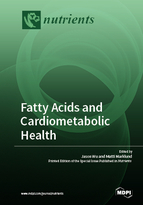Fatty Acids and Cardiometabolic Health
A special issue of Nutrients (ISSN 2072-6643).
Deadline for manuscript submissions: closed (15 October 2018) | Viewed by 80658
Special Issue Editors
Interests: food policy; nutrition epidemiology; food environment; cardiometabolic diseases
2. Department of Epidemiology, Johns Hopkins Bloomberg School of Public Health, Baltimore, MD 21205, USA
3. Department of Public Health and Caring Sciences, Uppsala University, 75122 Uppsala, Sweden
Interests: food policy; cost-effectiveness analysis for health interventions; comparative risk assessment; salt/sodium; nutritional epidemiology; dietary biomarkers; fatty acids; wholegrains
Special Issue Information
Dear Colleagues,
The impact of fat intake on hypercholesterolemia and related atherosclerotic cardiovascular diseases has been studied for decades. However, the current evidence base suggests that fatty acids also influences cardiometabolic diseases through other mechanisms including effects on glucose metabolism, body fat distribution, blood pressure, inflammation, and heart rate. Furthermore, studies evaluating single fatty acids have challenged the simplistic view of shared health effects within fatty acid groups categorized by degree of saturation. In addition, investigations of endogenous fatty acid metabolism, including genetic studies of fatty acid metabolizing enzymes, and the identification of novel metabolically derived fatty acids have further increased the complexity of fatty acids’ health impacts.
This Special Issue aims to include original research and up-to-date reviews on genetic and dietary modulation of fatty acids, and the role and function of dietary and metabolically derived fatty acids in cardiometabolic health.
Dr. Jason Wu
Dr. Matti Marklund
Guest Editors
Manuscript Submission Information
Manuscripts should be submitted online at www.mdpi.com by registering and logging in to this website. Once you are registered, click here to go to the submission form. Manuscripts can be submitted until the deadline. All submissions that pass pre-check are peer-reviewed. Accepted papers will be published continuously in the journal (as soon as accepted) and will be listed together on the special issue website. Research articles, review articles as well as short communications are invited. For planned papers, a title and short abstract (about 100 words) can be sent to the Editorial Office for announcement on this website.
Submitted manuscripts should not have been published previously, nor be under consideration for publication elsewhere (except conference proceedings papers). All manuscripts are thoroughly refereed through a single-blind peer-review process. A guide for authors and other relevant information for submission of manuscripts is available on the Instructions for Authors page. Nutrients is an international peer-reviewed open access semimonthly journal published by MDPI.
Please visit the Instructions for Authors page before submitting a manuscript. The Article Processing Charge (APC) for publication in this open access journal is 2900 CHF (Swiss Francs). Submitted papers should be well formatted and use good English. Authors may use MDPI's English editing service prior to publication or during author revisions.
Keywords
- Fatty acids
- Cardiometabolic health
- Risk factors
- Inflammation
- Glucose metabolism
- Diet








